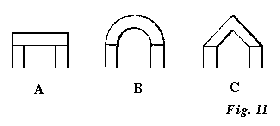252 THE STONES OF VENICE
§ 88. Now there are three good architectures in the world, and there never can be more, correspondent to each of these three simple ways of covering in a space, which is the original function of all architectures. And those three architectures are pure exactly in proportion to the simplicity and directness with which they express the condition of roofing on which they are founded. They have many interesting varieties according to their scale, manner of decoration, and character of the nations by whom they are practised, but all their varieties are finally referable to the three great heads-
A, Greek: Architecture of the Lintel.
B, Romanesque; Architecture of the Round Arch.
C, Gothic: Architecture of the Gable.
The three names, Greek, Romanesque, and Gothic, are indeed inaccurate when used 
§ 89. A. GREEK: Lintel Architecture. The worst of the three; and, considered with reference to stone construction, always in some measure barbarous. Its simplest type is Stonehenge; its most refined, the Parthenon; its noblest, the Temple of Karnak.1
In the hands of the Egyptian, it is sublime; in those of the Greek, pure; in those of the Roman, rich; and in those of the Renaissance builder, effeminate.
B. ROMANESQUE: Round-arch Architecture. Never thoroughly developed until Christian times. It falls into two great branches, Eastern and Western, or Byzantine and Lombardic; changing respectively in process of time, with
1 [Compare Vol. IX. p. 120 n.]
[Version 0.04: March 2008]